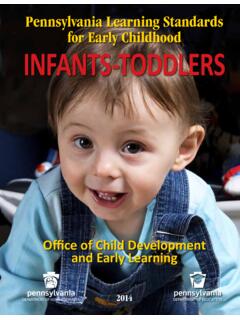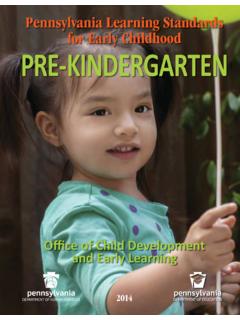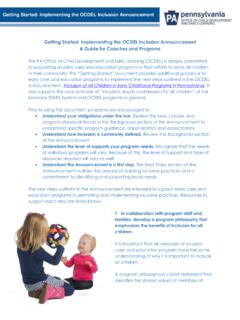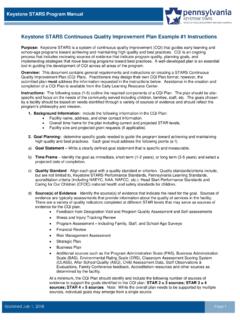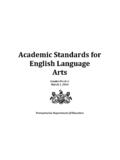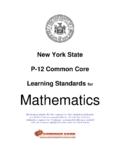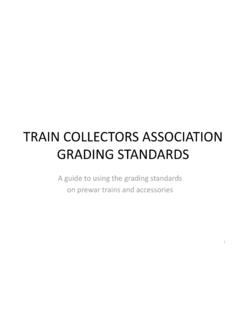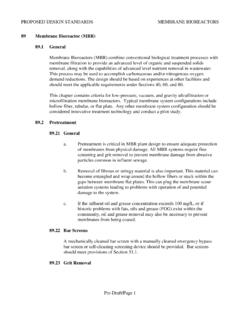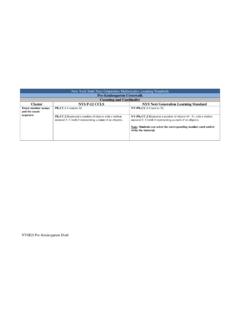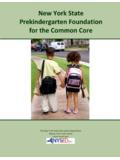Transcription of Pennsylvania Learning Standards for Early …
1 Pennsylvania Learning Standards for Early childhood PRE-KINDERGARTEN. Office of Child Development and Early Learning 2014. TABLE OF CONTENTS. Introduction.. 4. The Learning Standards Continuum.. 7. Guiding Principles.. 8. KEY Learning AREA: Approaches to Learning through Play Constructing, Organizing, and Applying Knowledge Standard Area : Constructing and Gathering Knowledge 11. Standard Area : Organizing and Understanding Information 12. Standard Area : Applying Knowledge 14. Standard Area : Learning through Experience 15. Approaches to Learning Glossary 17. KEY Learning AREA: Language and Literacy Development English Language Arts Standard Area : Foundational Skills 19. Standard Area : Reading Informational Text 20. Standard Area : Reading Literature 23. Standard Area : Writing 26. Standard Area : Speaking and Listening 29.
2 Language and Literacy Development Glossary 31. KEY Learning AREA: Mathematical Thinking and Expression Exploring, Processing, and Problem-Solving Standard Area : Numbers and Operations 34. Standard Area : Algebraic Concepts 35. Standard Area : Geometry 36. Standard Area : Measurement, Data, and Probability 38. Mathematical Thinking and Expression Glossary 40. KEY Learning AREA: Scientific Thinking and Technology Exploring, Scientific Inquiry, and Discovery Standard Area : Biological Sciences Living and Non-Living Organisms 42. Standard Area : Biological Sciences Genetics 43. Standard Area : Biological Sciences Evolution 44. Standard Area : Physical Sciences Chemistry 44. Standard Area : Physical Sciences Physics 45. Standard Area : Earth and Space Sciences Earth Structures, Processes, and Cycles 47. Standard Area : Earth and Space Sciences Origin and Evolution of the Universe 48.
3 Standard Area : Environment and Ecology Ecology 49. Standard Area : Environment and Ecology Watersheds and Wetlands 50. Standard Area : Environment and Ecology Natural Resources 50. Standard Area : Environment and Ecology Agriculture and Society 51. Standard Area : Environment and Ecology Humans and the Environment 51. Standard Area : Computer and Information Technology 52. Scientific Thinking Glossary 55. Environment and Ecology Glossary 55. Computer and Information Technology Glossary 56. 2. KEY Learning AREA: Social Studies Thinking Connecting to Communities Standard Area : Civics and Government Principles and Documents of Government 58. Standard Area : Civics and Government Rights and Responsibilities of Citizenship 58. Standard Area : Civics and Government How Government Works 59. Standard Area : Economics Scarcity and Choice 60.
4 Standard Area : Economics Markets and Economic Systems 60. Standard Area : Economics Functions of Government 61. Standard Area : Economics Income, Profit, and Wealth 61. Standard Area : Geography Basic Geographic Literacy 62. Standard Area : Geography Physical Characteristics of Places and Regions 62. Standard Area : History Historical Analysis and Skills Development 63. Social Studies Thinking Glossary 64. KEY Learning AREA: Creative Thinking and Expression Communicating through the Arts Standard Area : Production and Performance Music and Movement 66. Standard Area : Production and Performance Dramatic and Performance Play 67. Standard Area : Production and Performance Visual Arts 68. Standard Area : Historical and Cultural Context of Works in the Arts 69. Standard Area : Critical Response to Works in the Arts 69.
5 Standard Area : Aesthetic Response to Works in the Arts 70. Creative Thinking and Expression Glossary 70. KEY Learning AREA: Health, Wellness, and Physical Development Learning About My Body Standard Area : Concepts of Health 72. Standard Area : Healthful Living 73. Standard Area : Safety and Injury Prevention 74. Standard Area : Physical Activity Gross Motor Coordination 74. Standard Area : Concepts, Principles, and Strategies of Movement Fine Motor Coordination 75. Health, Wellness, and Physical Development Glossary 77. KEY Learning AREA: Social and Emotional Development Student Interpersonal Skills Standard Area : Self-Awareness and Self-Management 79. Standard Area : Establishing and Maintaining Relationships 81. Standard Area : Decision-Making and Responsible Behavior 83. Social and Emotional Development Glossary 84.
6 KEY Learning AREA: Partnerships for Learning Families, Early Care and Education Programs, and Communities Standard : Families are supported in times of need. 86. Standard : Families experience relationships with Early care and education programs that are affirming, reciprocal, and build upon their strengths. 88. Standard : Families have the support and information they need to encourage their children's Learning and development. 90. Standard : Family members have support from other families. 92. Standard : Families have goals of their own and benefit from having supportive partners to help reach their goals. 92. Standard : Families grow in their leadership and use these skills in many different ways. 93. Standard : Families are supported in times of transition. 94. Resources.. 96. 3. Learning Standards Development Pennsylvania 's Learning Standards for Early childhood were originally constructed as a joint project of the Departments of Education and Human Services.
7 The Office of Child Development and Early Learning in col- laboration with the Office of Elementary and Secondary Education have overseen revisions to the Standards . Each set of Standards has been formulated with help and guidance from practitioners and program special- ists who represented Early childhood programs, school districts, higher education, family leaders, policy analysts, and researchers. A group of Pennsylvania educators, in conjunction with the Office of Child Devel- opment and Early Learning , created a set of Pennsylvania Core Standards beginning with Pre-Kindergarten. The Pennsylvania Core Standards start in Pre-Kindergarten and continue through 12th grade. The Pennsyl- vania State Board of Education adopted the Pennsylvania Core Standards in March 2014. The 2014 revisions include updates related to the Pennsylvania Core Standards ; Science, Technology, Engineering, and Math (STEM) supportive practices; and current research trends.
8 Learning Standards for Early childhood are used to: Inform professionals about curriculum and assessment Guide the selection of instructional materials and the design of interactions/goal setting Inform families of appropriate expectations for children Provide a common framework for community-based birth grade 3 alignment work Learning Standards for Early childhood are NOT used as: A specific curriculum A means to prohibit children from moving from one grade or age level to another Introduction C hildren are born with an incredible capacity and desire to learn. More than 40 years of research confirms the founda- tional importance of Early education and care for children's school and life success. It is essential that children's first experiences are robust ones, steeped in activities that develop critical thinking and tions), safe and supportive schools, and materials and resources.
9 A. web-based portal including more information and resources related to these elements is accessible at Standards ALIGNED SYSTEM (SAS). problem-solving skills, a deep understanding about themselves in a social society, and age-appropriate content. Instructional practices must embed the domains of development . Standards . cognitive, social-emotional, language, and physical with approaches to Learning that enable children to explore, understand, and reach beyond the here and now to challenge themselves, experiment, and transform information into meaningful content and skills. SAFE AND. SUPPORTIVE ASSESSMENT. Professionals interacting with young children have the critical task of SCHOOLS. providing rich information and experiences. Such experiences build skills and understanding in the context of everyday routines and within intentionally-designed play opportunities that capture children's inter- STUDENT.
10 Ests and curiosity. Pennsylvania 's Learning Standards for Early Child- ACHIEVEMENT. hood are designed to support and enhance the Learning environment;. responsive relationships; age, cultural, and linguistically-appropriate MATERIALS. CURRICULUM. curriculum; and practices being used to assess children, classrooms, AND. FRAMEWORK. and programs. RESOURCES. The Department of Education and the Office of Child Development and Early Learning use a Standards Aligned System. The Standards Aligned INSTRUCTION. System is a collective body of research that identifies six elements which, when used together, provide a framework for program improve- ment and child success. The elements identified are Standards , as- sessments, curriculum framework, instruction (including interven- 4. 1. Standards Education in Science, Technology, Engineering, and Math beginning Learning Standards provide the framework for Learning .)
